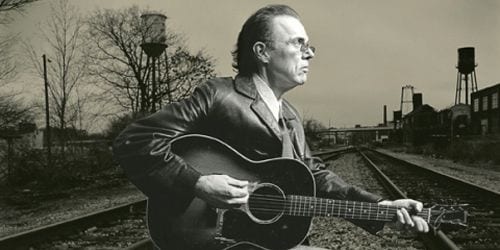
The last we heard from John Hiatt, he was singing “Let’s Give Love a Try”, the final tune from 2008’s Same Old Man. On that song, Hiatt admitted, “Sometimes I don’t like being where I am”, a notion that Hiatt has explored for much of his going-on-40-year career as a singer-songwriter. Calling himself “old” (sort of) in the title of that record marked a transition of sorts for a rascal like Hiatt, who was 55 when Same Old Man was released. It makes sense that Hiatt would feel road-weary at this point, bearing the experience of relentless writing, recording, and touring across four decades of personal and professional ups and downs. And, indeed, Hiatt sounded ragged on much of Same Old Man; Hiatt’s voice, of course, has long been the source of family debates, but on his last album, he sang as though a dishrag was stuck in his larynx.
Despite signs of wear and tear, Hiatt’s alacrity for writing great melodies and unshitty lyrics was solidly intact, and in “Let’s Give Love a Try”, he sings “I got just enough left to wanna see what’s next”. Sure, he was talking about his capacity for new love, but it’s hard not to consider a broader view for this journeyman and to wonder what Hiatt has left to say as an artist and where he goes from here. The answer to those questions comes with The Open Road, Hiatt’s 18th studio album, a cycle of songs that finds him reclaiming his status as a rascally rambler, kicking out ahead of the rest, and mythologizing the highway and its machines with more urgency than anyone since ’78-era Springsteen.
The opening track and title cut starts with a squalling guitar riff, signaling that, musically, the record will be Hiatt’s meanest, leanest platter in a decade. He’s backed by Doug Lancio on guitar, Patrick O’Hearns on bass, and longtime cohort Kenneth Blevins on drums, and this quartet makes for a gritty set, one almost entirely free of additional instrumentation or overdubs or other studio futzing. The result is an album that catches Hiatt and the boys playing live in the studio, where they provide a conversant, propulsive boogie to Hiatt’s desperate road songs. Part of that back-to-basics return also allows for some of Hiatt’s bluesiest turns — the middle section of the record slows to a series of electric, third-verse-same-as-the-first blues songs.
As simple, structurally, as the songs on The Open Road are, Hiatt has too much integrity to phone in his lyrics and has always been one of roots-rock’s masters at massaging clever melodies out of four-chord progressions. The record is spilling over with breezy wordplay, some of it funny enough to forgive him for those groaners on “Little Head” a few years back. Here, he casts a bleary eye on aging, regret, and the need to, against all logic, keep rambling away from stability and lasting love. The themes are freighted with the fatigue of Hiatt’s weatherbeaten voice; however, while he sounds more pinched than a decade ago, The Open Road finds Hiatt in fuller voice than last time out, and he’s able to squeeze out those mischevious falsetto yelps with plenty of aplomb.
Hiatt has long been drawn to road imagery, whether driving South, going to Memphis in the meantime, riding with the King, or flashing Tennessee plates. But on The Open Road, these images reflect a less jubilant escape; the open road in these songs is a place “where the hopeless come” and where “they bring their broke-down loads”. Even when the music is upbeat, as on the jumpy, Chuck Berry-esque “Haulin’”, the lyrics veer toward the darkness; “Haulin’” starts off as a comin’-home-to-see-my-baby driving song (“Sun comes up and I’m crossin’/Kentucky state line, gonna see my girl”), but we later find out that the narrator isn’t just haulin’, he’s fleeing after killing a man (“I cut him and I coasted through Conway/Put him by the side of the road”).
Despite the fatalistic resignation in many of these songs, Hiatt vows to keep fighting, as in “Go Down Swingin’”; he admit that he’s a contradictory man (“Sometimes I’m a predator/Prowlin’ for my life/Other times I’m a field mouse/Runnin’ for the sides), but that he has plenty of fight left in him, a sentiment that enmeshes these songs of restless wandering with the urge to survive. “Go Down Swinging’”, by the way, sounds an awful lot like Tom Petty’s “Swingin’” from his 1999 album Echo. (Now there’s a good idea for a tour.)
Repeating past melodies or metaphors — his own or others’ — is a risk inhered in a songwriter as prolific as Hiatt, and there are few out there who have been as relentlessly productive as he has. The songs are full of well-worn tropes about freight trains and the wonder of love, but while some of the songs feel recycled (“My Baby” sounds like Chili’s baby-back ribs jingle), and the blues songs certainly feel lived-in, Hiatt’s wry lyrics and knack for small, but unique, twists (the end of the chorus on “What Kind of Man”, for instance) make these songs unique.
Ultimately, the contradiction that Hiatt owns up to serves as the record’s controlling theme — a need for connection that kicks against a need to keep traveling: “Right here’s where you and I belong/Always movin’ on”. By the album’s end, the narrator pleads for the security of a woman’s arms and a place to stay — “Baby, can you carry me back home?” On the other hand, there will always be latent flight in a rambler like Hiatt, and it’s this spirit that keeps Hiatt going. If he keeps making records as solid as The Open Road, that spirit is something to celebrate.
